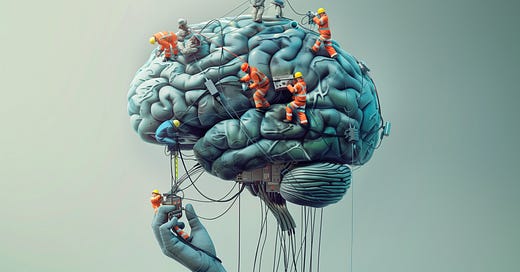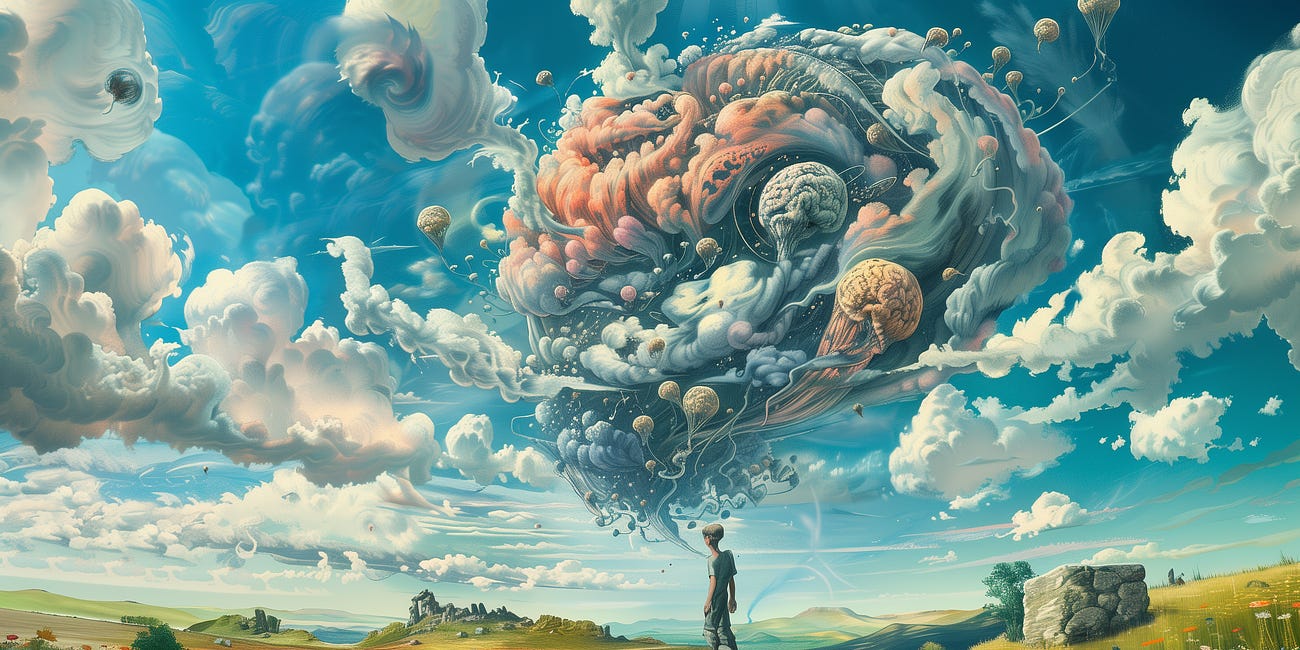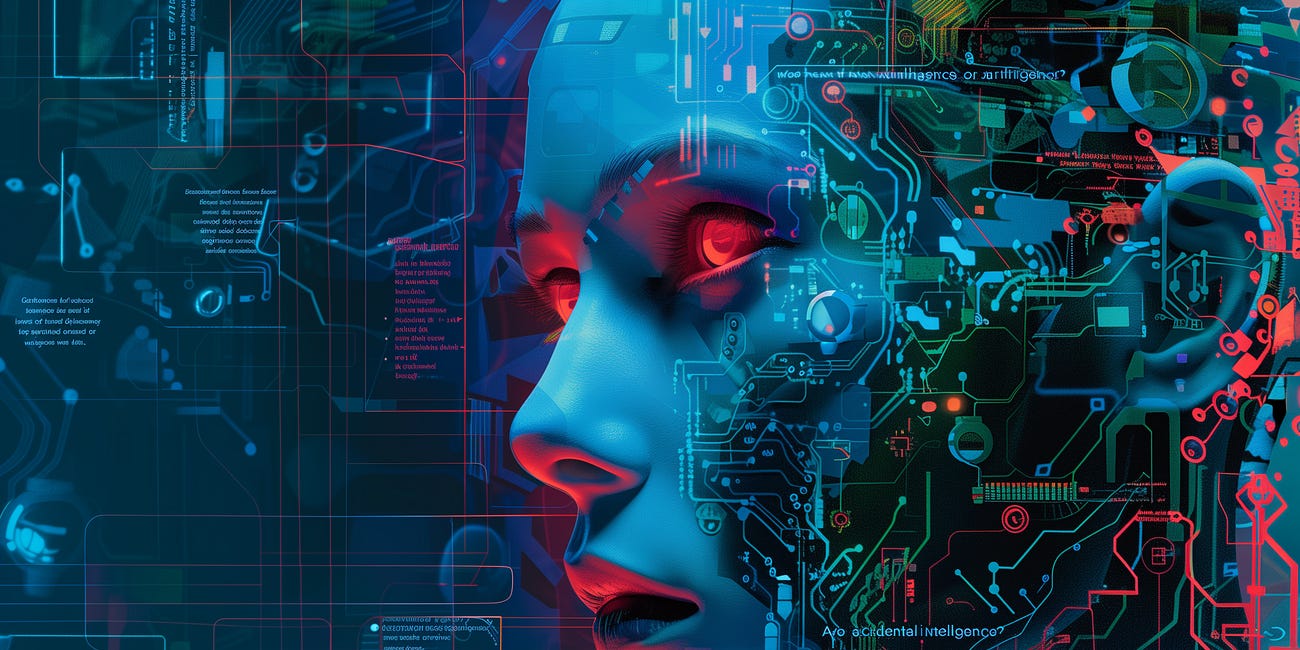Thoughts Rewire Our Brains
In this story, we learn that seeing is not believing, believing is seeing. We also look at a study on insights to illustrate how thoughts physically rewire our brains to make it easier to think those same thoughts in the future.
TLDR: I’ll summarize this story for you.
The “Virtual Reality of Reality” that we all experience everyday needs raw data from the universe to look as similar as possible from moment-to-moment to produce the highest quality story in our heads—the story with the most coherence.
“Persistence of Consciousness” might be the purpose of the Observer Effect in Quantum Mechanics, but the primary goal of the brain is “Coherence of Consciousness”. Coherence is so important to our brains that our subconscious minds will contort our bodies in all kinds of crazy ways to keep our eyes level and steady throughout the day. Your eyes are probably level right now regardless of whatever position your body is in.
Here is a video of a cheetah running in slow motion. Just watch how aggressively its body works to keep its eyes level and steady while running full speed. (4 mins)
Watch this Kingfisher keep its eyes level and steady while perched on a reed blowing in the wind. It’s mesmerizing. (1 min)
@photographers: Our heads are mounted on top of our necks with a “synovial pivot joint” that works just like a gimbal, so image stabilization is built into our rig. 📷
Coherent Imagination
Our subconscious minds work that hard all day to help us build a coherent story in our heads. It not only influences our bodies to work that hard, it also means our imaginations are working that hard. In the previous story, “The Quantum Neural Network”, we learned how 99.7% of every “pixel” we see is imagined, so imagination is the most important tool we have for building a coherent story in our heads.
Imagination is both the greatest thing that ever happened to us, and the worst. It’s the worst because we lie to ourselves everyday without knowing it. Sometimes we mistakenly see things that aren’t real. Sometimes we sell ourselves elaborate excuses that aren’t real. None of us wants to see ourselves as the monsters we all are. 😈
@timferris: “Don’t believe everything you think” is genius. Those five words definitely deserve a billboard and a bumper sticker.
Most of the lies we sell ourselves each day are fairly innocuous. Some “hallucinations” simply come from the way our imagination fills in the blanks for 99% of our vision. When our subconscious imagination is unsure, like p-values near 0.5, our imaginations make a best guess using all the information they have trained on during our entire lives.
My favorite example of this is human faces. Infants come out of the womb looking for human faces. When you sample faces from all around the world, some ethnic groups have larger eyes or larger noses—there are millions of subtle differences. But when you average all the human faces all around the world together, the size and spacing of all our facial features use the Golden Ratio. The Golden Ratio is a number that looks like this:
1 : 1.61803398874989484820...The Golden Ratio looks complicated but it’s actually based on a very simple math formula which starts with just two numbers: 0 and 1. To get the next number in the sequence, you add the two numbers together, which is 1. Then you keep adding just the previous two numbers together, indefinitely, to get a sequence that looks like this:
0, 1, 1, 2, 3, 5, 8, 13, 21, 34, 55, 89, 144, 233...This is called the Fibonacci sequence. The next number in the sequence above would be:
144 + 233 = 377The ratio between any two adjacent numbers approximates the Golden Ratio:
233 is 1.618 times 144. 377 is 1.618 times 233.The farther you go along the Fibonacci sequence, the “more golden” the ratio between the two adjacent numbers.
The Golden Ratio shows up all over our bodies too. Stand in front of a mirror and have a look at yourself. The distance from the top of your head to your belly button, and the distance from your belly button to the floor have a ratio of 1 : 1.618. If you have “long legs”, they are long compared to the Golden Ratio.
Now look at your hands. The length of you middle finger compared to the length of your palm is the Golden Ratio. If you have “stubby fingers”, they are stubby compared to the Golden Ratio. Your upper arm compared to your forearm use the Golden Ratio, just like your upper leg compared to your lower leg.
Now look at your face. The top of your head to your eyeline and your eyeline to your chin is the Golden Ratio. The bottom of your nose to your lip and then your lip to your chin is the Golden Ratio. So when we say someone has a big nose, it’s big compared to the Golden Ratio.
Scientists studying Beauty created a “Golden Ratio Mask” based on the Fibonacci sequence so they could mathematically compare real human faces to it. Here’s the mask overlaid on the face of Angelina Jolie.
She’s beautiful, but scientists have concluded that the world’s most “mathematically beautiful” women are Gigi Hadid, Beyoncé, and Shania Twain. Our subconscious minds apply the same Golden Ratio to men. Regé-Jean Page, Chris Hemsworth, and Michael B. Jordan are currently the world’s most “mathematically attractive” men. Tap on the image below to the see the top 10.
The Golden Ratio seems to be a critical design decision for most of the plant and animal kingdoms too. Here is good video that demonstrates how the Golden Ratio shows up everywhere in nature. (10 mins)
Okay, so here’s why the Golden Ratio is important for understanding the innocuous ways our imaginations lie to us everyday. Have you ever seen an attractive person on the street from behind and then casually maneuvered to see more of their face? It’s almost always a disappointment, right? That’s because when our imagination is unsure, it fills in the unknown parts of their faces using the Golden Ratio, and no one is that pretty except Gigi Hadid.
@fridaynightlightsfans: Actually, I ran into Minka Kelly one time at the supermarket checkout line. When she turned around, she was so much prettier than my brain was expecting that it stopped working for a second. 😵💫
She smiled and said hello, but I just stared at her confused until it was long enough to be embarrassing. I didn’t have TV for years back then so I didn’t know who she was, but Derek Jeter lived in my neighborhood during spring training so it didn’t take long to figure it out. More than a decade later, I told that story while playing golf with another one of Minka Kelly’s ex-boyfriends and his buddy made a face like, “yeah, she does that to people”. 🤣
Believing Is Seeing
The Golden Ratio strongly affects our interpretation of reality, but what about our beliefs?
My favorite explanation for how our brains see what they believe comes from psychologist Gary Klein. Over his career, Gary Klein accumulated real world data on 120 major scientific discoveries and innovations throughout human history. Some examples include the discovery of DNA, various military victories, and the invention of the Escape Fire by Wagner Dodge. Behavioral economists love to talk about Wagner Dodge—you’ll hear about him or the Mann Gulch fire in about half their books.
In 30 of these 120 scenarios, Klein found a second team competing to achieve the exact same goals. The “losing team” had all the same information as the “winning team”, but they failed to make the same discovery. These 30 scenarios allowed Klein to study and classify Insight under life and death consequences in the field, as opposed to studying it in a psychology lab playing games for nickels and quarters. Klein published his research in a book titled, “Seeing What Others Don’t: The Remarkable Ways We Gain Insight”.
I fall in love with almost every book, but I really love this one.
Klein describes the mind as a Collection of Beliefs that combine in various ways to create Stories. For example, let’s use the simple statement, “The sky is blue.” That’s a story. You have beliefs from your past related to the word “sky”. You have beliefs from your past related to the word “blue”. You even have beliefs from your past related to the word “is”.
When you combine these beliefs into the story, “The sky is blue”, your neural network automatically calculates a statistical confidence interval for the entire story. If I told you, “The sky is blue” at night, your Bayesian confidence would be very different than if I told you that same story during the day. You don’t have to consciously calculate doubt. You feel doubt. That’s how integral doubt is to our lives.
What I like about this “collection of beliefs” idea is that it dovetails nicely with our neurobiology. Our neural networks hold our beliefs in nodes, just like an artificial neural network. The axonal connections between our neurons carry a signal strength for how strongly the ideas should be connected because human brains are Large Language Models, just like ChatGPT.
Seeing What We Believe
The point of all those examples in Klein’s book is that our neural networks generate real patterns of physical electricity that change with each thought.
Computer scientists have trained digital neural networks to watch the electrical patterns in our quantum neural networks to guess what we are seeing and hearing in the real world. These algorithms are way smarter than just guessing if we are thinking about the word “sky”. These algorithms can look at the electrical patterns in our neural networks and reconstruct what our eyes are seeing.
Here’s a story about it from NBC news, “From brain waves, this AI can sketch what you're picturing”.
Here’s a nerdier example from IEEE Spectrum, “Can AI and fMRI “Hear” Unspoken Thoughts?”.
And if you really want to nerd-out on it, here is “Hyperrealistic neural decoding for reconstructing faces from fMRI activations via the GAN latent space”.
I’ve reviewed several of these experiments and they are all extremely impressive. And scary. The longer an AI is allowed to train on a human’s neural network, the more accurately it will predict its thoughts. But what’s most surprising about this research is that even when these algorithms are tested on a human neural network they’ve never seen, they still guess far more accurately than chance.
In another local news story, AI researchers read their human subjects this quote from the Wizard of Oz:
When she had finished her meal
and was about to go back to the road of yellow brick
she was startled to hear a deep groan nearby
Researchers cleverly chose the passage that introduces the scarecrow, who doesn’t have a brain. The local news reporter covering the story asked the researchers to try their algorithm on him without any prior training. Here’s what the AI thought the reporter heard, in English, just by watching his neural network hear the quote above:
The whole day I’d be fine
but she wanted me to make it to her place first
I got a little excited about it
The algorithm’s guesses may reveal more about the young male reporter than he knows. When the reporter heard the word “groan”, it was highly correlated to the idea of “excitement” in his brain. And evidently the “yellow brick road” leads back to “her place”.
The fact that artificial intelligence can be directionally correct on a brain it has never seen, leads me to believe that there is some kind of standardized way that we organize beliefs in our quantum neural networks.
@legislators: The more our computers know about us, the easier we are to manipulate. The accuracy of these predictions will continue to improve from the resolution of our brain scanners and the sophistication of our artificial intelligence. Algorithmic Liability Laws are sorely needed and hopefully Mental Privacy Laws will follow because WWIII is an influence war.
Here is a little more about this tech from my friend, Azeem Azhar, at the Exponential View. (24 mins)
Rewiring Our Neural Networks
In his book, “Seeing What Other’s Don’t”, Gary Klein calls the patterns of beliefs that we use most often, Intuition. These patterns get worn in, which allows our decision-making to get faster and more instinctual.
Whenever a neuron routes traffic in our neural networks, cells called Oligodendrocytes wrap that neuron’s axon in a Myelin sheath to insulate its electrical signals. Basically our neural networks physically install broadband cable along these routes. This insulation increases the strength of the connections, which increases the likelihood of seeing patterns with that neuron in the future. 👀
So our brains perpetually rewire themselves to increase the confidence in our existing beliefs. There’s a very valid, biological reason why it’s hard to teach an old dog new tricks: our brains employ adaptive hardware.
The neurons that route the most neural network traffic hold our Anchor Beliefs, and sometimes these are just too important to let go. In Klein’s research, the most common reason the losing team missed the major insight was because they held onto a False Anchor much longer than the winning team. There are lots of ways we collect false anchors, so Klein has entire chapters titled “Stupidity”, “Dumb by Design”, and “How Organizations Obstruct Insight”. His examples are fascinating.
So Klein’s two paths to gain insights are:
substituting a False Anchor for a better one
adding a totally new Anchor Belief to an existing Story.
This is how we actually see what others don’t. The new anchors allow a totally new pattern of electricity to form within our neural network, creating a totally new idea that had never existed before. I wrote this book to help you find whatever False Anchors are not working for you in your own life. This book is simply a buffet of the best Anchor Beliefs from the world's smartest nerds.
Reweighting Our Neural Networks
Manually adjusting the “weights” of our own beliefs can have dramatic effects on our lives. Our beliefs determine the actual price we’re willing to pay for our faith, and I don’t just mean that religiously. I mean every thought is a belief, so every action we take in this world is a demonstration of faith in something. Even when we go to sit down in a chair, we are demonstrating our faith in the chair.
Seriously, every action we take in life is a demonstration of faith. So instead of a religious example, let’s use a story from computer science to illustrate this point.
The Winklevoss twins are the hunky twins who went to Harvard with Mark Zuckerberg and accused him of stealing their work. They got boxed out of Facebook by Zuckerberg and then got boxed out of Silicon Valley (also by Zuckerberg). The Winklevosses got a bad settlement, but they were clever enough to keep that money invested in Facebook stock to let Emperor Zuck work for them. That decision was a demonstration of their faith in Facebook and social media in general.
After their exile from Sand Hill Road, the twins were hanging out in Ibiza when a guy named David Azar first told them about a recently published whitepaper by Satoshi Nakamoto. What they read changed their lives. Satoshi Nakamoto is the anonymous inventor of Bitcoin, which is powered by a novel Blockchain technology that decentralized financial accounting. The Winklevosses were forced to add new Beliefs into the massive neural network of Stories they already held about the Internet, money, government, behavioral economics, and everything else in their experience. Their new beliefs about Bitcoin created new patterns of electricity in their neural networks that had never been possible before. These new Anchors had to be reconciled with all their existing anchors.
There were two opposing stories. Bitcoin would either:
be completely worthless because no one would ever care about invisible money
become the currency of the internet by disintermediating central banks
Ultimately they chose ‘b’ and demonstrated their faith by purchasing 120,000 Bitcoins under $10 each. Think about how early that was. That’s when one bitcoin could only buy one pizza. Today, that one Winklevoss trade is worth around five billion dollars. Cameron and Tyler Winklevoss went on to found Gemini, a cryptocurrency brokerage, which even further demonstrated their faith in crypto.
Inside each Winklevoss neural network, there are neurons that route traffic for the concept of “cryptocurrency”. In the decade it took to build their crypto business, just think about how many times those neurons were used during thoughts and conversations. Those Winklevoss brains have physically adapted to make it easier for them to think about cryptocurrency in every context.
Today, the Winklevoss twins are among the leading evangelists for Non-Fungible Tokens (NFTs), which help manage digital scarcity on the internet. Their success validates their technological chops and even adds weight to the story that Zuckerberg probably stole something from them.
@christians: While we’re talking about changing weights in neural networks, let’s look at the phrase “glorify the Lord” in a new way.
In English translations of the New Testament, the word glorify is used to replace the Greek word doxazo about 85% of the time. Doxazo means “exercising personal opinion to determine a value”, like calculating a price. Before paper money that meant adding weight to a scale, which is why Israeli Shekels and British Pounds are measures of weight. In the Old Testament, the word glorify replaces the ancient Hebrew word kabowd, which also means to add weight.
So “glorify the Lord” doesn’t mean you need to be Jesus freaks, out in the street, handing tickets out for God. “Glorify the Lord” literally means “make God heavy in your heart, in your soul, and in your mind”. 😉
Continue reading…
Partly Cloudy Brainstorms
In this story, we discuss reinforcement learning and the chemical molecules our brains use for rewards. We learn how these molecules lead us into addiction, and why periodic fasting is so important for maintaining a healthy brain.
Table of Contents
The Computer Science of Everything
God isn’t some old, white man with magical powers. God is a quantum computer scientist with super advanced technologies.
Huge Thanks 🙏
to all our sponsors. Your support helped us reach new academics, scholars, and scientists all around the world through social media.
Caitlin Knauss
Worth Denison
Alana Aviel
Anonymous
Jeremy Wells
Ronnie Blanton
Tarrytown Bible study
If this content was helpful to you, please consider investing in our mission to spread the Good News of Jesus Christ. “Love your neighbor as yourself” might be the only reason that artificial super intelligence doesn’t kill us all.
Donate by credit card or bank transfer:
Donate Bitcoin to this address: bc1qsn9xrd3yrfg4zqydc5aqns3uwvhrdqay8d7vht
Donate by subscribing to our investor newsfeed:
Wanna chat about this story? Email us or leave a comment below:
What did you love the most?
What did you hate the most?
What surprised you the most?
What confused you the most?

























